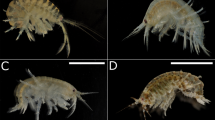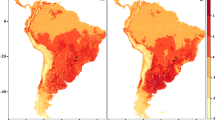Abstract
The impact of invasions on local biodiversity is well established, but their impact on regional biodiversity has so far been only sketchily documented. To address this question, we studied the impact at various observation scales (ranging from the microhabitat to the whole catchment) of successive arrivals of non-native amphipods on the amphipod assemblage of the Loire River basin in France. Amphipod assemblages were studied at 225 sites covering the whole Loire catchment. Non-native species were dominant at all sites in the main channel of the Loire River, but native species were still present at most of the sites. We found that the invaders have failed to colonize most of tributaries of the Loire River. At the regional scale, we found that since the invaders first arrived 25 years ago, the global amphipod diversity has increased by 33% (from 8 to 12 species) due to the arrival of non-native species. We discuss the possibility that the lack of any loss of biodiversity may be directly linked to the presence of refuges at the microhabitat scale in the Loire channel and in the tributaries, which invasive species have been unable to colonize. The restoration of river quality could increase the number of refuges for native species, thus reducing the impact of invaders.



Similar content being viewed by others
References
Bij de Vaate A, Jazdzewski K, Ketelaars HAM, Gollasch S, van der Velde G (2002) Geographical patterns in range extension of Ponto-Caspian macroinvertebrates species in Europe. Can J Fish Aquat Sci 59:1159–1174
Bollache L, Devin S, Wattier R, Chovet M, Beisel JN, Moreteau JC, Rigaud T (2004) Rapid range extension of the Ponto-Caspian amphipod Dikerogammarus villosus in France: potential consequences. Arch Hydrobiol 160:57–66
Casellato S, Visentin A, La Piana G (2007) The predatory impact of Dikerogammarus villosus on fish. In: Gherardi F (ed) Biological invaders in inland waters: profiles, distribution, and threats. Springer, Berlin, pp 495–506
Chovet M, Lécureuil JY (1994) Répartition des Gammaridae épigés (Crustacés, Amphipodes) dans la Loire et les rivières de la Région Centre (France). Ann Limnol 30:11–23
Crowder LB, Cooper CE (1982) Habitat structural complexity and the interaction between bluegills and their prey. Ecology 63:1802–1813
Devin S, Beisel JN (2007) Biological and ecological characteristics of invasive species: a gammarid study. Biol Inv 9:13–24
Devin S, Beisel JN (2008) Geographic patterns in freshwater gammarid invasions: an analysis at the pan-European scale. Aquat Sci 70:100–106
Devin S, Piscart C, Beisel JN, Moreteau JC (2003) Ecological traits of the amphipod invader Dikerogammarus villosus on a mesohabitat scale. Arch Hydrobiol 158:43–56
Dick JTA (1996) Post-invasion amphipod communities of Lough Neagh, Northern Ireland: influences of habitat selection and mutual predation. J Anim Ecol 65:756–767
Dick JTA, Platvoët D (2000) Invading predatory crustacean Dikerogammarus villosus eliminates both native and exotic species. P R Soc London B Biol Sci 267:977–983
Dick JTA, Platvoët D, Kelly DW (2002) Predatory impact of the freshwater invader Dikerogammarus villosus (Crustacea: Amphipoda). Can J Fish Aquat Sci 59:1078–1084
Dufrêne M, Legendre P (1997) Species assemblages and indicator species: the need for a flexible asymmetrical approach. Ecol Monogr 67:345–366
Füreder L, Pöckl M (2007) Ecological traits of aquatic NIS invading Austrian fresh waters. In: Gherardi F (ed) Biological invaders in inland waters: profiles, distribution, and threats. Springer, Berlin, pp 233–257
Goedmakers A (1974) Les Gammaridea (Crustaces, Amphipodes) du Massif Central. Bull Zool Mus Univ Amsterdam 3:211–219
Grabowski M, Bacela K, Konopacka A (2007) How to be an invasive gammarid (Amphipoda: Gammaroidea)—comparison of life history traits. Hydrobiologia 590:75–84
Jazdzewski K (1980) Range extensions of some gammaridean species in European inland waters caused by human activity. Crustaceana Suppl 6:84–107
Jazdzewski K, Roux AL (1988) Biogéographie de Gammarus roeselii Gervais en Europe, en particulier en France et en Pologne. Crustaceana suppl 13:272–277
Jazdzewski K, Konopacka A, Grabowski M (2002) Four Ponto-Caspian and one American gammarid species (Crustacea, Amphipoda) recently invading Polish water. Contrib Zool 71:115–122
Jazdzewski K, Konopacka A, Grabowski M (2004) Recent drastic changes in the gammarid fauna (Crustacea, Amphipoda) of the Vistula River deltaic system in Poland caused by alien invaders. Divers Distrib 10:81–87
Kohonen T (2001) Self-organizing map. Springer, Heidelberg
Lasne E, Bergerot B, Lek S, Laffaille P (2007a) Fish zonation and indicator species for the evaluation of the ecological status of rivers: example of the Loire basin (France). River Res Appl 23:877–890
Lasne E, Lek S, Laffaille P (2007b) Patterns in fish assemblages in the Loire floodplain: the role of hydrological connectivity and implications for conservation. Biol Conserv 139:258–268
Lécureuil JY, Chovet M (2003) Connexion entre les bassins hydrographiques européens et dissémination des espèces aquatiques: le cas de la Loire moyenne. Symbioses 9:25–31
Lek S, Scardi M, Verdonschot PFM, Descy JP, Park YS (2005) Modelling community structure in freshwater ecosystems. Springer, Berlin
Leppäkoski E, Gollasch S, Olenin S (2002) Invasive aquatic species of Europe: distribution, impacts and management. Kluwer, Dordrecht
MacNeil C, Dick JTA, Gell FR, Selman R, Lenartowicz P, Hynes HBN (2008a) A long-term study (1949–2005) of experimental introductions to an island; freshwater amphipods (Crustacea) in the Isle of Man (British Isles). Divers Distrib 15:232–241
MacNeil C, Platvoët D, Dick JTA (2008b) Potential roles for differential body size and microhabitat complexity in mediating biotic interactions within invasive freshwater amphipod assemblages. Fund Appl Limnol 172:175–182
Pinkster S, Smit H, Brandse de Jong N (1977) The introduction of the alien amphipod Gammarus tigrinus Sexton, 1939, in the Netherlands and its competition with indigenous species. Crustaceana Suppl 4:91–105
Piscart C, Moreteau JC, Beisel JN (2005) Biodiversity and structure of macroinvertebrate communities along a small permanent salinity gradient (Meurthe River, France). Hydrobiologia 551:227–236
Piscart C, Manach A, Copp GH, Marmonier P (2007) Distribution and microhabitats of native and non-native gammarids (Amphipoda, Crustacea) in Brittany, with particular reference to the endangered endemic sub-species Gammarus duebeni celticus. J Biogeogr 34:524–533
Piscart C, Maazouzi C, Marmonier P (2008) Range expansion of the North American alien amphipod Gammarus tigrinus Sexton, 1939 (Crustacea: Gammaridae) in Brittany, France. Aquat Inv 3:449–453
Piscart C, Dick JTA, McCrisken D, MacNeil C (2009) Environmental mediation of intraguild predation between the freshwater invader Gammarus pulex and the native G. duebeni celticus. Biol Inv. doi:10.1007/s10530-009-9497-1
Platvoët D (2007) Dikerogammarus villosus (Sowinsky, 1894), an amphipod with bite. The relationship between morphology, behaviour, micro-distribution and impact of this invading crustacean. Ph. D thesis, University of Amsterdam, Amsterdam
Pont D, Hugueny B, Oberdorff T (2005) Modelling habitat requirement of European fishes: do species have similar responses to local and regional environmental constraints? Can J Fish Aquat Sci 62:163–175
Power M (1992) Habitat heterogeneity and the functional significance of fish in river food webs. Ecology 73:1675–1688
Rahel FJ (2002) Homogenisation of freshwater faunas. Annu Rev Ecol Syst 33:291–315
Rahel FJ, Olden JD (2008) Assessing the effects of climate change on aquatic invasive species. Conserv Biol 22:521–533
Ricciardi A (2007) Are modern biological invasions an unprecedented form of global change? Conserv Biol 21:329–336
Richardson DM, Pysek P (2008) Fifty years of invasion ecology–the legacy of Charles Elton. Divers Distrib 14:161–168
Sala OE, Chapin FS, Armesto JJ, Berlow E, Bloomfield J, Dirzo R, Huber-Sanwald E, Huenneke LF, Jackson RB, Kinzig A, Leemans R, Lodge DM, Mooney HA, Oesterheld M, Poff NL, Sykes MT, Walker BH, Walker M, Wall DH (2000) Global biodiversity scenarios for the year 2100. Science 287:1770–1774
van der Velde G, Nagelkerken I, Rajagopal S, bij de Vaate A (2002) Invasions by alien species in inland freshwater bodies in western Europe: the Rhine Delta. In: Leppäkoski E, Gollash S, Olenin S (eds) Invasive aquatic species of Europe: distribution, impacts and management. Kluwer, Dordrecht, pp 360–372
van Riel MC, Healy EP, van der Velde G, bij de Vaate A (2007) Interference competition among native and invader amphipods. Acta Oecol 31:282–289
Wijnhoven S, van Riel MC, van der Velde G (2003) Exotic and indigenous freshwater gammarid species: physiological tolerance to water temperature in relation to ionic content of the water. Aquat Ecol 37:151–158
Acknowledgments
We would like to thank Valérie Briand for her essential help with literature resources and the two anonymous referees for their valuable comments. This study was supported by the 2005 PAPIER project of the ECosphére COntinentale program, and the InBioProcess project (ANR-06-BDIV-007-InBioProcess (2007–2010) of the 2006 Biodiversity program of the National Research Agency (Agence Nationale de la Recherche, ANR).
Author information
Authors and Affiliations
Corresponding author
Rights and permissions
About this article
Cite this article
Piscart, C., Bergerot, B., Laffaille, P. et al. Are amphipod invaders a threat to regional biodiversity?. Biol Invasions 12, 853–863 (2010). https://doi.org/10.1007/s10530-009-9506-4
Received:
Accepted:
Published:
Issue Date:
DOI: https://doi.org/10.1007/s10530-009-9506-4




